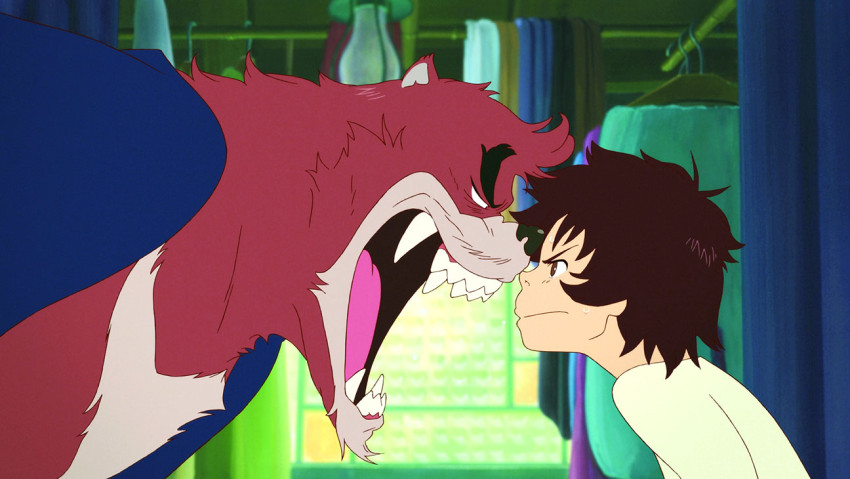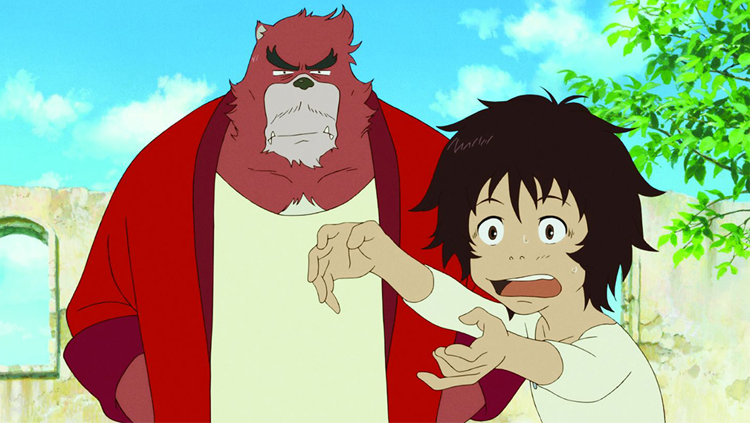The Boy and the Beast
September 4, 2017 · 0 comments
By Andrew Osmond.
 Early on in Mamoru Hosoda’s new film The Boy and the Beast, a child is whisked – dare we say spirited? – to a world of strange, magical beings. As the terrified boy rushes pell-mell through bright lights and food stalls, anime fans will think of a certain Ghibli film, and wonder if Hosoda is claiming Miyazaki’s mantle. Well, no. After this fleeting moment, the film quickly goes down its own road. Much of it’s a double act between the kid and a rumbustious bear-man, between our world and Wonderland, and a story that’s funny and serious in ways that are different from how Miyazaki films were funny and serious.
Early on in Mamoru Hosoda’s new film The Boy and the Beast, a child is whisked – dare we say spirited? – to a world of strange, magical beings. As the terrified boy rushes pell-mell through bright lights and food stalls, anime fans will think of a certain Ghibli film, and wonder if Hosoda is claiming Miyazaki’s mantle. Well, no. After this fleeting moment, the film quickly goes down its own road. Much of it’s a double act between the kid and a rumbustious bear-man, between our world and Wonderland, and a story that’s funny and serious in ways that are different from how Miyazaki films were funny and serious.
But like it or not, Hosoda is saddled with the “next Miyazaki” tag, like Makoto Shinkai before him. That’s reasonable. Miyazaki and Hosoda make films which, by and large, you could show to people with no knowledge or interest in anime. They’re accessible to fans of Pixar or Potter – or to use an example Miyazaki gave, to a Japanese country grandpa. Their films don’t do fan service; they don’t start from otaku templates (moe, mecha). Spirited Away invited comparisons to Alice. Boy and the Beast starts like an urban Lion, the Witch and the Wardrobe, as runaway nine year-old Ren follows a shaggy figure into a maze of Tokyo alleys, then to another world.
This is the realm of Jutengai, a city of market stalls and stone buildings, based on Marrakech in Morroco. Unlike many film fantasies, Jutengai’s animal-faced people are shown working and living in their own “real” lives, with no suggestion that they’re part of a dream. However, Ren has several moments of realisation in the film that the people in Jutengai have problems and issues very like his own. Take the bear-like Beast that Ren followed, who’s named Kumatetsu. The hairy bruiser may look fearsome, but he’s an underdog and outsider like Ren himself. Kumatetsu is desperate to find an apprentice to help him win through Jutengai’s fighting tournaments and become the world’s new ruler… though that’s not what the film’s really about.
The beastly Kumatetsu – voiced by Koji Yakusho, famed as the live-action lead in The Eel, Shall We Dance and 13 Assassins – invites non-anime comparisons. For a start, he looks like a more disreputable relative of his Disney namesake in Beauty and the Beast. His rough-housing, rough-father personality – “I hate cry-babies!” – echoes Long John Silver (who probably influenced a classic anime character, Ma Dola in Laputa). In the English dub of the film, Kumatetsu is voiced by the prolific John Swasey, who already has a track-record in playing scary dads; he’s Gendo in the Evangelion films, and Van Hohenheim in Fullmetal Alchemist Brotherhood.
 Like Chihiro in Spirited Away, Ren must stand up to a hail of cuffs and pummelling, both from Kumatetsu and other characters in Jutengai. On this blog, Gundam creator Yoshiyuki Tomino suggested that young characters must be shown in such sorry straits. “Humans have to overcome pains; at least in drama and fiction, surely they are okay.”
Like Chihiro in Spirited Away, Ren must stand up to a hail of cuffs and pummelling, both from Kumatetsu and other characters in Jutengai. On this blog, Gundam creator Yoshiyuki Tomino suggested that young characters must be shown in such sorry straits. “Humans have to overcome pains; at least in drama and fiction, surely they are okay.”
Boy and the Beast involves pain, but also a load of physical comedy, more than any Hosoda film since his One Piece picture Baron Omatsuri & The Secret Island. Kumatetsu angrily chases Ren (who he renames Kyuta) in rings round a table; later on, there’s a sequence where the boy mimics Kumatetsu’s every movement, up to the inevitable bit where Kumatetsu zigs, zags and feints to throw Ren off. These scenes could have been lifted from live-action slapstick or a Bugs Bunny cartoon. But they’re much better integrated into the film than the cartoon moments in Hosoda’s past works (like the nose bleed at the end of Summer Wars), and suggest an evolution in his comedy.
Otherwise, the animation in Boy and the Beast shines most in its fight scenes, which will be the obvious focus for “sakuga” buffs. There’s a great market brawl between Kumatetsu and a tusked rival, by turns nimble and muscular. It’d be interesting to know if it was all by one artist, or by two artists switching places midway through. A later, much more pivotal battle feels a little uneven, with the characters feeling momentarily weightless when they’re not slamming together; but it’s all very hearty entertainment.
These fights feel cathartic in a story about angry, unhappy children. Like numerous anime, Boy and the Beast’s themes overlap with those of Pixar’s Inside Out, but suggest that kids don’t just contain cute emotions; they harbour primal monsters from the Id. But the film also has beautiful fantasy wish-fulfilment, especially in the way Ren learns to move freely between magic Jutengai and mundane Tokyo. The story’s action sloshes between realities, with no need for the cyberspaces of Summer Wars or Digimon. (Even Monsters Inc didn’t make it this easy.) The wonderland of Boy and the Beast is fully permeable to us, a true world next door to our ordinary life.
I loved the film – I’m not sure if it’s my favourite Hosoda pic, but it’s a rich new flavour for him. There’ve been complaints that Boy and the Beast feels too mainstream, even too Disney, but it does more with its tropes than the vast majority of geek-genre offerings. It may not have time-travel or cyberspace, but Boy and the Beast is still wholly Hosoda.
Andrew Osmond is the author of 100 Animated Feature Films. The Boy and the Beast is released in the UK by Studio Canal.
Leave a Reply